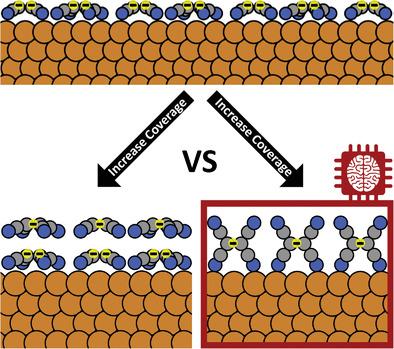Our official English website, www.x-mol.net, welcomes your
feedback! (Note: you will need to create a separate account there.)
Charge Transfer into Organic Thin Films: A Deeper Insight through Machine‐Learning‐Assisted Structure Search
Advanced Science ( IF 14.3 ) Pub Date : 2020-06-28 , DOI: 10.1002/advs.202000992 Alexander T. Egger 1 , Lukas Hörmann 1 , Andreas Jeindl 1 , Michael Scherbela 1 , Veronika Obersteiner 1 , Milica Todorović 2 , Patrick Rinke 2 , Oliver T. Hofmann 1
Advanced Science ( IF 14.3 ) Pub Date : 2020-06-28 , DOI: 10.1002/advs.202000992 Alexander T. Egger 1 , Lukas Hörmann 1 , Andreas Jeindl 1 , Michael Scherbela 1 , Veronika Obersteiner 1 , Milica Todorović 2 , Patrick Rinke 2 , Oliver T. Hofmann 1
Affiliation

|
Density functional theory calculations are combined with machine learning to investigate the coverage‐dependent charge transfer at the tetracyanoethylene/Cu(111) hybrid organic/inorganic interface. The study finds two different monolayer phases, which exhibit a qualitatively different charge‐transfer behavior. Our results refute previous theories of long‐range charge transfer to molecules not in direct contact with the surface. Instead, they demonstrate that experimental evidence supports our hypothesis of a coverage‐dependent structural reorientation of the first monolayer. Such phase transitions at interfaces may be more common than currently envisioned, beckoning a thorough reevaluation of organic/inorganic interfaces.
中文翻译:

电荷转移到有机薄膜中:通过机器学习辅助结构搜索获得更深入的了解
密度泛函理论计算与机器学习相结合,以研究四氰基乙烯/ Cu(111)杂化有机/无机界面处的覆盖率依赖性电荷转移。该研究发现了两个不同的单层相,它们在质上表现出不同的电荷转移行为。我们的研究结果驳斥了以前将电荷远距离转移到不与表面直接接触的分子的理论。取而代之的是,他们证明了实验证据支持了我们对第一个单层的覆盖依赖性结构重新定向的假设。界面上的此类相变可能比当前设想的更为普遍,这要求对有机/无机界面进行彻底的重新评估。
更新日期:2020-08-05
中文翻译:

电荷转移到有机薄膜中:通过机器学习辅助结构搜索获得更深入的了解
密度泛函理论计算与机器学习相结合,以研究四氰基乙烯/ Cu(111)杂化有机/无机界面处的覆盖率依赖性电荷转移。该研究发现了两个不同的单层相,它们在质上表现出不同的电荷转移行为。我们的研究结果驳斥了以前将电荷远距离转移到不与表面直接接触的分子的理论。取而代之的是,他们证明了实验证据支持了我们对第一个单层的覆盖依赖性结构重新定向的假设。界面上的此类相变可能比当前设想的更为普遍,这要求对有机/无机界面进行彻底的重新评估。











































 京公网安备 11010802027423号
京公网安备 11010802027423号